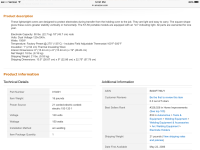Just as big a problem as the hydrogen that is released when welding is that of rust of the steel electrode. When any rod whether it be cellulose coated like the 6010 or iron powder like the 7018 is left exposed to moisture, the iron core will start to rust. How fast depends on the amount of moisture. Cellulose rods don't absorb moisture like the iron powder rods do but will eventually become unusable if left in a high moisture environment as evidenced by the white powder that will form on the outside of the flux. Can you still weld farm equipment with it? Likely you can although the flux will start to "fingernail" that is it will start to burn off faster on one side than the other and leave a long point (fingernail) on one side that makes the arc a bit unstable.
The iron powder rods (xx18) rods will start to have lots of porosity even if you stick the rod and let it heat up till the cloud of steam erupts from it. This is because of the coating of rust on the electrode that you cant see by looking at the outside. Again, you may get "fit for purpose" welds for farm machinery from it as long as you get the water vapor out. The rust will just cause a bit of porosity that while weakening the weld, does not weaken it to point of it failing to hold the part together in most cases.
Hydrogen embrittlement which happens when water is welded over on in case of wet rods is very dangerous as it can cause the weld to fail catastrophically ( as in break in half with no warning and without bending or yielding ). This is very dangerous in lifting mechanism that could be holding something overhead or in something like bridge spans.
I keep my rods in an oven because it basically cost me nothing to do so AND more importantly because I have done so for more than 40 years in the construction industry (25 of which was in Quality Control Management) so it is a habit I really don't want to break.
My shop is on a separate meter and has a minimum charge which I don't normally go over unless I do a lot of welding. So if I didn't use the electricity to heat my rods, I would just be giving it to the electric company anyway. At over $2 per pound (last time I checked pricing which was a few years ago) having 50 lbs. of rods go bad will pay for a lot of electric utility.
I usually read 1-2 lines then skim through a long-ish post to see if something jumps out at me and something jumped out. I picture an electric oven running none stop on high heat keeping electrodes dry costing a little more than, lets say atleast 2 X more than nothing, almost a wow factor to me,

